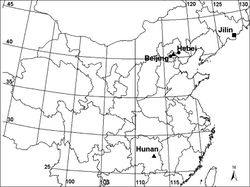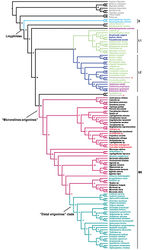Acanoides
| Notice: | This page is derived from the original publication listed below, whose author(s) should always be credited. Further contributors may edit and improve the content of this page and, consequently, need to be credited as well (see page history). Any assessment of factual correctness requires a careful review of the original article as well as of subsequent contributions.
If you are uncertain whether your planned contribution is correct or not, we suggest that you use the associated discussion page instead of editing the page directly. This page should be cited as follows (rationale):
Citation formats to copy and paste
BibTeX: @article{Sun2014ZooKeys375, RIS/ Endnote: TY - JOUR Wikipedia/ Citizendium: <ref name="Sun2014ZooKeys375">{{Citation See also the citation download page at the journal. |
Ordo: Araneae
Familia: Linyphiidae
Name
Acanoides Sun & Marusik & Tu, 2014 gen. n. – Wikispecies link – ZooBank link – Pensoft Profile
Type species
Acanoides beijingensis sp. n.
Composition
Two species, Acanoides beijingensis sp. n. and Acanoides hengshanensis (Chen & Yin, 2000) comb. n.
Diagnosis
The males of Acanoides gen. n. can be distinct from Acanthoneta by the sharp embolus proper, the slender lamella characteristica unbranched, and by the Fickert’s gland located in the membranous area outside the radix (Figs 2D, 3D). The females can be distinguished by the ventrally folded extensible epigynal basal part (Figs 2F, 3F).
Description
Male total length 2.34–2.73; female total length 2.10–2.42. Carapace yellowish-brown. Male carapace unmodified. AMEs smallest, others subequal; from the dorsal view AER recurved, PER straight, eyes separated by AMEd, ALE and PLE juxtaposed. Chelicerae medium-sized, with strong stridulatory ridges, female fang groove with three promarginal and three retromarginal teeth in Acanoides beijingensis sp. n., and two promarginal and two retromarginal teeth in Acanoides hengshanensis. Chaetotaxy: Ti I–IV: 2-2-2-2; Mt I–IV: 1-1-1-1; Mt I of males with two rows of ventral bristles, one prolateral, one retrolateral (Fig. 1C, 1D); Tm I about 0.25, Tm IV absent. Both species have a haplotracheate system. Male palp (Figs 2A–E, 3A–E, 4A–B, 5A–B). Cymbium with proximal apophysis. Paracymbium medium to large-sized, with one tooth on lateral margin. Distal suprategular apophysis not modified as pit hook, or absent. Embolic division: radix long and narrow, Fickert’s gland located in the membranous area connecting radix and embolus; embolus wide and strongly sclerotized with serrated area, embolus proper sharp with a thumb and an apex at each side; lamella characteristica unbranched, long and narrow with sharp sclerotized apex, almost parallel to radix; terminal apophysis with distal membrane. Epigynum (Figs 2F–H, 3F–G, 4G–H, 5G–H). Protruding, with deeply wrinkled basal part, extensible and ventrally folded in constricted state. Epigynum well sclerotized, epigynal cavity present (in Acanoides beijingensis sp. n.) or absent (in Acanoides hengshanensis), both scape and stretcher absent.
Etymology
The genus name, Acanoides, is a combination of the first four letters of “Acanthoneta” and the last five letters of “Wubanoides”. “-oides” itself in Latin means “similar to”, masculine in gender.
Phylogenetics
Due to limitations of the current dataset the monophyly of Acanoides could not be tested explicitly in our phylogenetic analyses, however it is supported by the following four putative synapomorphies: sharp embolus proper, slender and unbranched lamella characteristica, outside radix located Fickert’s gland and ventrally folded extensible epigynal basal part.
Distribution
China (Beijing, Hunan, Hebei) (Fig. 7).
Remarks
The males of Acanoides gen. n. have the palp of a “micronetine” type: presence of the Fickert’s gland, the boat-shaped radix, the trunk-like embolus with a pointed proper and a thumb, as well as the well developed terminal apophysis and lamella characteristica (Saaristo and Tanasevitch 1996[1]). However, these sclerites in Acanoides (Fig. 2D) have some features different from the normal “micronetine” type (Fig. 6F, Saaristo and Tanasevitch 1996[1]): Fickert’s gland is not embedded within the radix, but located in the membranous area connecting the radix and the embolus; and the embolus has a wide, strongly sclerotized body, with a longer and sharper embolus proper, whereas in most “micronetines” the embolus is usually trunk-like with a pointed embolus proper. The male palp of both Acanoides and Acanthoneta, have a long and slender lamella characteristica parallel to the long radix, but with an additional long and thin branch in Acanthoneta (Fig. 6F), unbranched in Acanoides (Figs 2D, 3D). The epigynum of Acanthoneta is in a normal “micronetine” type, with a sigmoid scape surrounded by an epigynal cavity (Fig. 6H), but with an extensible basal part in Acanoides. The result of phylogenetic analysis based on molecular data indicates that Ipainae is not a monophyletic group as the movable epigynum independently evolved in Acanoides and Solenysa (Appendix - Fig. S1). This is also supported by the tracheal characters: haplotracheate type in Acanoides, but intermediate type in Solenysa, with the median pair extending into the prosoma (Tu and Hormiga 2011[2]). We infer that the extensible basal part of the epigynum may have also evolved convergently with that in other ipaines. In Acanoides it differs by being ventrally folded, while it forms a solenoid in Solenysa (Tu & Hormiga, 2011), and folds inwards in other ipaines, e.g. Ipa (Saaristo 2007[3]: fig. 29), Wubanoides and Epibellowia (Tanasevitch 1996[4]: figs 7–9). Furthermore, the male palp of typical ipaines has filiform embolus proper (Saaristo 2007[3]: fig. 7; Tanasevitch 1996[4]: figs 1, 4) much longer than that of Acanoides (Fig. 2D).
Original Description
- Sun, N; Marusik, Y; Tu, L; 2014: Acanoides gen. n., a new spider genus from China with a note on the taxonomic status of Acanthoneta Eskov & Marusik, 1992 (Araneae, Linyphiidae, Micronetinae) ZooKeys, 375: 75-99. doi
Other References
- ↑ 1.0 1.1 Saaristo M, Tanasevitch A (1996) Redelimitation of the Subfamily Micronetinae Hull, 1920 and the Genus Lepthyphantes Menge, 1866 with Descriptions of Some New Genera (Aranei, Linyphiidae). Berichte naturw.-mediz. Verein Innsbruck 83: 163-186.
- ↑ Tu L, Hormiga G (2011) Phylogenetic analysis and revision of the linyphiid spider genus Solenysa (Araneae: Linyphiidae: Erigoninae). Zoological Journal of the Linnean Society 161: 484-530. doi: 10.1111/j.1096-3642.2010.00640.x
- ↑ 3.0 3.1 Saaristo M (2007) A new subfamily of linyphiid spiders based on a new genus created for the keyserlingi-group of the genus Lepthyphantes (Aranei: Linyphiidae). Arthropoda Selecta 16: 33-42.
- ↑ 4.0 4.1 Tanasevitch A (1996) Reassessment of the spider genus Wubanoides Eskov, 1986 (Arachanida: Araneae: Linyphiidae). Reichenbachia Mus. Tierkd. Dresden 1996: 123-129.
Images
|
![Figure 1. Acanoides beijingensis sp. n. (A–C) and Acanoides hengshanensis (D–F). A male, dorsal B female, dorsal C male, lateral, rectangle indicates ventrolateral rows of bristles on Mt I D male, lateral, rectangle indicates ventrolateral rows of bristles on Mt I E male, dorsal F female, dorsal. [Scale bars: mm].](https://species-id.net/o/thumb.php?f=ZooKeys-375-075-g001.jpg&width=248)
![Figure 2. Acanoides beijingensis sp. n. A male palp, prolateral B male palp, prolateral, with embolic division removed C male palp, retrolateral D embolic division, ventral E embolic division, dorsal F epigynum, ventral G epigynum, dorsal H epigynum, lateral. CG copulatory groove; CO copulatory opening; DP dorsal plate; EA extensible area of epigynal basal part; EM embolic membrane; EP embolus proper; FG fertilization groove; FiG Fickert’s gland; LC lamella characteristica; MP median plate; P paracymbium; PCA proximal cymbial apophysis; R radix; S spermathecae; TA terminal apophysis; TH thumb of embolus; VP ventral plate. [Scale bars: mm].](https://species-id.net/o/thumb.php?f=ZooKeys-375-075-g002.jpg&width=187)
![Figure 3. Acanoides hengshanensis. A male palp, prolateral B male palp, ventral C male palp, retrolateral, arrow indicates pointed tooth on posterolateral margin D embolic division, ventral E embolic division, dorsal F epigynum, ventral G epigynum, dorsal. CG copulatory groove; CO copulatory opening; DP dorsal plate; EA extensible area of epigynal basal part; EM embolic membrane; EP embolus proper; FG fertilization groove; FiG Fickert’s gland; LC lamella characteristica; P paracymbium; PCA proximal cymbial apophysis; R radix; S spermatheca; TA terminal apophysis; TH thumb of embolus; VP ventral plate. [Scale bars: mm].](https://species-id.net/o/thumb.php?f=ZooKeys-375-075-g003.jpg&width=213)
![Figure 4. Acanoides beijingensis sp. n. A palp (embolic division removed), prolateral B palp, retrolateral, arrow indicates half rounded lateral tooth on paracymbium C embolic division, ventral D embolic division, dorsal E detail of D F detail of C G epigynum, ventral H epigynum, dorsal. AX apex of embolus; CG copulatory groove; CO copulatory opening; DM distal membrane of terminal apophysis; DSA distal suprategular apophysis; EA extensible area of epigynal basal part; EM embolic membrane; EP embolus proper; FG fertilization groove; LC lamella characteristica; MP median plate; P paracymbium; PCA proximal cymbial apophysis; R radix; S spermatheca; SE serrated area on embolus; SPT suprategulum; TA terminal apophysis; TH thumb of embolus; VP ventral plate. [Scale bars: mm].](https://species-id.net/o/thumb.php?f=ZooKeys-375-075-g004.jpg&width=189)
![Figure 5. Acanoides hengshanensis. A palp (embolic division removed), prolateral B palp, retrolateral, arrow indicates pointed tooth on posterolateral margin C embolic division, ventral D embolic division, dorsal E detail of D F detail of C G epigynum, ventral H epigynum, dorsal. AX apex of embolus; CG copulatory groove; CO copulatory opening; DM distal membrane of terminal apophysis; EA extensible area of epigynal basal part; EM embolic membrane; EP embolus proper; FG fertilization groove; LC lamella characteristica; P paracymbium; PCA proximal cymbial apophysis; R radix; S spermatheca; SPT suprategulum; TA terminal apophysis; TH thumb of embolus; VP ventral plate. [Scale bars: mm].](https://species-id.net/o/thumb.php?f=ZooKeys-375-075-g005.jpg&width=188)
![Figure 6. Acanthoneta dokutchaevi (A–G) and Acanthoneta aggressa (H–J). A male, dorsal B male, lateral C male palp, prolateral D male palp, ventral E male palp, retrolateral F embolic division, ventral G embolic division, dorsal H epigynum, ventral I epigynum, posterior J epigynum, lateral (H–J photos provided by Don Buckle). EB epigynal basal part; EM embolic membrane; EP embolus proper; FiG Fickert’s gland; LC lamella characteristica; P paracymbium; PCA proximal cymbial apophysis; PH pit hook; R radix; SC scape; ST stretcher; TA terminal apophysis; TH thumb of embolus. [Scale bars: mm].](https://species-id.net/o/thumb.php?f=ZooKeys-375-075-g006.jpg&width=179)

